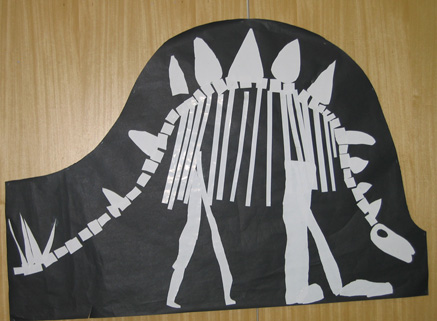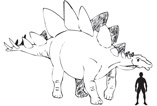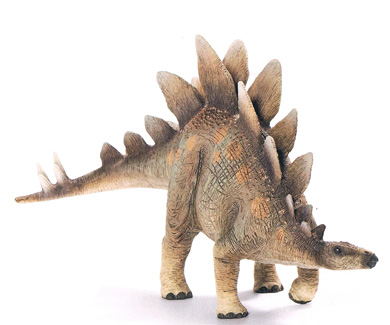Young Palaeontologists Reconstruct a Beautiful Stegosaurus Skeleton
Children at West Walton Community Primary School Learn about Dinosaurs
Children in the reception class at West Walton Community Primary have been learning all about dinosaurs and fossils this term, under the enthusiastic tutelage of the teaching and support staff at the school.
The budding young palaeontologists have been excavating dinosaur bones out in the school yard, creating pictures and writing stories about prehistoric animals, they even got the chance to produce some lovely artwork. Spotted in pride of place on one of the walls of the reception classroom was this beautifully constructed illustration of the skeleton of the dinosaur known as Stegosaurus. When asked, the children were eager to share their knowledge of dinosaurs, explaining that Stegosaurus was a plant-eater, with plates on his back, spikes on his tail and this dinosaur had a very small brain – no bigger than a walnut.
Stegosaurus Skeleton Artwork
The Stegosaurus Illustration in the Classroom
Picture credit: West Walton Community Primary School
Mrs Hughes, one of the reception class teachers explained that the children had been very keen to study dinosaurs this term and when it came to creating the class’s own Stegosaurus skeleton the children were determined to make it as accurate as they could. She told a team member at Everything Dinosaur who visited the school, that one little boy even measured the ribs in order to make sure they were the right size.
Stegosaurus Illustration
It is certainly a very commendable effort and Stegosaurus is one of the most iconic of all the members of the Dinosauria. As for the small brain size, the walnut metaphor seems to be universally accepted and team members at Everything Dinosaur have come across it on many occasions. It is true that when the brain to body size ratio for a large number of dinosaurs is considered, then in comparison with their huge bulk, a lot of dinosaurs do seem to have possessed very small brains indeed. Using a walnut to describe the brain size of a dinosaur, seems to date back more than one hundred years.
One of the earliest examples, of the “walnut phrase” being used comes from a illustrated book “Mighty Animals”, first published in 1912. The description was applied to the Late Jurassic dinosaur Diplodocus, not Stegosaurus.
There is a reference to the eminent American palaeontologist Edwin Colbert describing the Stegosaurus brain as “being not much bigger than a walnut” back in 1945 and within Everything Dinosaur’s extensive reference library, we have come across one description from shortly after the Second World War that describes the brain of Stegosaurus as being “only as big as a prune”.
A Scale Drawing of Stegosaurus
Picture credit: Everything Dinosaur
Knowledge of Neuroanatomy
As our knowledge of neuroanatomy has developed so our interpretation of intelligence has changed. The crude measure of body size to brain size, does not necessarily give an indication of “intelligence”, as different behaviours in animals can be seen as a form of intelligence. For example, the brain of the grey squirrel is small, these little rodents that leap about in the trees at the back of Everything Dinosaur’s warehouse, still exhibit remarkable feats of memory far superior to our own when it comes to locating nuts that they have buried.
Another method of estimating relative intelligence is the Encephalisation Quotient (EQ). This analysis is based on the principle of comparing the brain volume of the animal being studied to the brain volume of a control animal with approximately the same body weight. Here too, the assumption is that animals with larger brains to body ratios are more intelligent than animals with smaller brains to body size ratios.
Cold-blooded bony fish such as the Pacific Salmon have a brain size just one tenth of that of a similar sized mammal, yet these fish are capable of navigating thousands of miles and making their way upstream, overcoming all sorts of obstacles and obstructions.
Although, the likes of Stegosaurus had very small brains, these animals were clearly well adapted to their environments and we as a species have much more to learn about when it comes to estimating relative intelligence and defining intelligent behaviours in the rest of the Animal Kingdom. After all, Homo sapiens has been around as a species for over two hundred thousand years, but the Stegosaurs as a group may have existed for more than thirty-five million years.
Stegosaurus – Well Adapted to its Environment
Picture credit: Everything Dinosaur
Perhaps the budding palaeontologists inspired by the teaching staff at West Walton Community Primary will one day carry out some research the helps improve our understanding and interpretation of intelligent behaviours in the Kingdom Animalia.
To view models of stegosaurs and other other armoured dinosaurs take a look at the PNSO model collection: PNSO Prehistoric Animal Models and Figures.




